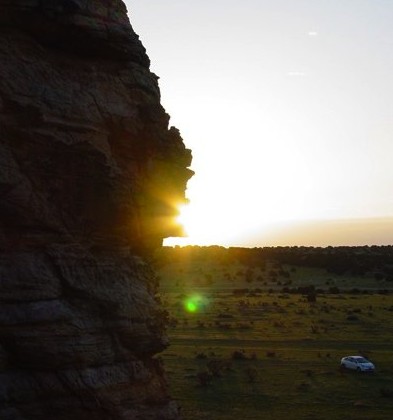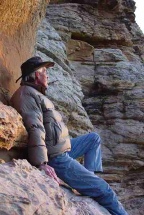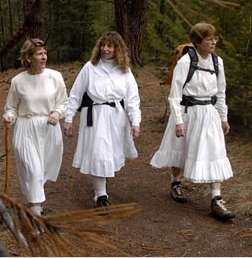Baca County Beltane
 In the photo, the Beltane Sun (astronomical Beltane--May 5) has recently risen. When it appeared on the horizon, it fit right into the little notch in the rock just below its current position--an alignment that happens only on Beltane and Lammas.
In the photo, the Beltane Sun (astronomical Beltane--May 5) has recently risen. When it appeared on the horizon, it fit right into the little notch in the rock just below its current position--an alignment that happens only on Beltane and Lammas.The site, on private land, is known to the students of archaeological sites as "the Sun Temple." I went there last weekend with filmmaker Scott Monahan, researcher Phil Leonard, and Martin Brennan, author of several books on Irish megalithic alignments, including The Boyne Valley Vision and The Stones of Time.
Some people prepare for ritual with baths and meditation, but maybe a 150-mile drive into the gradually darkening prairie works as well. A little synchronicity: on the way to La Junta, I heard the NPR report on the Neolithic temple unearthed in Ireland.
We camped at the site. A wall of lightning flickered silently to the north. Some 200 miles to the east, Greensburg, Kan., was being obliterated, but we did not know it. Our part of Colorado, which had been smashed by blizzards last winter, was warm and quiet. A great horned owl and a screech owl called from the cliffs.
 Left: Martin Brennan viewing the sunrise.
Left: Martin Brennan viewing the sunrise. On of the cliffs, someone centuries ago scraped the rock smooth and pecked a circle a little bigger than a human head. If you sit precariously so that your head is in the circle, then you see the alignment. A couple of alleged ogham inscriptions are nearby.
I am not qualified to judge the ogham, but I know that more and more (although still few) people visit such sites at the appropriate days. They watch as the old drama of sky, Sun, and rock plays out for a few seconds on a quarter or cross-quarter days. Afterwards, I suspect, they feel a little different about their place on this planet and on the southern High Plains.
Labels: archaeology, Colorado, nature religion
 Ladies in White, three women in Missoula, Montana,
Ladies in White, three women in Missoula, Montana, 



